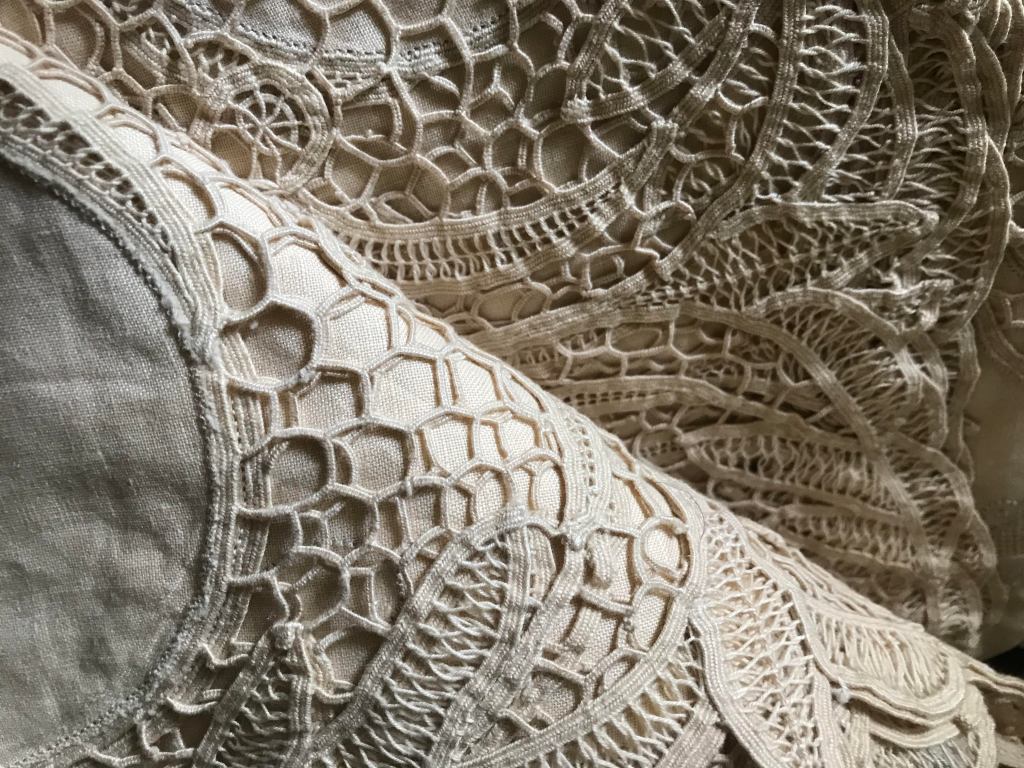
The trousseau is an antique Italian tradition of our grandmothers and mothers too, to donate towels, sheets, and all kitchen equipment to the spouse. Being born a female in Italy, in old times, was just a burden for the parents. While male were going to work, providing for themselves, parents had to dote the young girl getting married with real property, usually the house where she was going to live with her husband, and the expensive trousseau, plus kitchen equipment.
After the elementary school, if the girls were not continuing school, almost the totality of them, they were receiving a embroidery frame to learn how to do the needlework, and stitches while playing.So, finished school, the mothers were buying to their young girls, linen or tela of Monza, and they were teaching them to work on their trousseau. This was going to become their priority until they were finding a wealthy husband.
The girls were going to embroider towels, table cloths, sheets, and personal items, curtains, quilts, blankets etc. The wealthier family were going to prepare a trousseau of 12 items for each section, the less fortunate, only 6. The trousseau included crocheted blankets, table clothes, towels with initials and so on. Once finished, they were not going to be washed but preserved inside a wooden trunk.

Who does remember that terrible smell of camphor?
The preservation could take long time, but when the girl was finding a wealthy man, he was invited at lunch, the trunk was going to be opened to show the dote to all his family member and friends.A week before the wedding, all the girlfriends of the spouse were coming to the house, and helping to wash the trousseau by hand, the hard to remove stains were bleached and the sheets or items were hanged under the sun to dry in wire lines.
This was not too long ago, this was my grandmother’s timeframe, before the war. When I was child, time changed a little bit, girls were going to school, so it was my mother and grandmother working on my troisseau. I learned crochet and knitting, during the summers when I was visiting my grandmother every day. I never learned the embroidery art.
I was conversating with other people of my generation and we all have the same problem, we have the trousseau, which takes a lot of room, and we never use it. Mine was washed in the cleaners, for the fine fabric, ironed and packaged. It is still in its original package, worth a life of work, very elaborate, hand made and MADE in ITALY, but what do I do with it?

Today I went through it, like all girls open the trunk, and I felt proud of my grandmother and mother. They had good taste for the times, and I decided to put a table cloth in my kitchen table. Even the every day sheets have a lot of work on them, and are delicate to wash.
I can only take pictures of them and show off. They are too precious to be used, and memories are within them. My grandmother is no longer with us but her legacy is.

Il Corredo
Il corredo e’ una vecchia tradizione italiana delle nostre nonne e mamme, di donare tovaglie, lenzuola e set da tavola alla sposa. Nascere femmina in Italia, ai vecchi tempi, era un peso per i genitori. il maschio andava a lavorare e si poteva mantenere, mentre la femmina aveva bisogno della dote, normalmente un bene immobile dove andare a vivere col marito, la batteria da cucina e il corredo.
Dopo la scuola elementare, se le ragazze non continuavano la scuola, quasi la totalità di esse, gli veniva comprato un telaio da ricamo per imparare a ricamare e lavorare con l’ago.Quindi finita la scuola, le madri compravano stoffe di lino, cantu’, o tela di Monza ed insegnavano loro a lavorare al loro corredo, ovviamente, questa diventava la loro attivita’ principale prima che trovassero il “partito buono”.

Le ragazze ricamavano asciugamani, tovaglie da tavola, lenzuola, coperte, copricoperte, biancheria intima, sottane, tende ecc. Le famiglie più abbienti preparavano 12 set di ogni categoria, quelle meno abbienti circa 6. Il corredo comprendeva tovaglie con iniziali, coperte di uncinetto, lenzuola ricamate e, una volta finite, non venivano lavate, ma conservate in un baule. Chi si ricorda quell’ odore di naftalina?
Sarebbero stati conservati per molto tempo, quando, pero’, la ragazza trovava il partito buono, il futuro sposo veniva invitato a pranzo e il baule veniva aperto per mostrare la dote ai familiari di lui e amici. Una settimana prima del matrimonio, tutte le amiche si riunivano a casa della sposa e lavavano il corredo a mano, per le macchie più testarde si candeggiava e il bucato veniva steso al sole nei fili di ferro.
Non parlo di tanto tempo fa, ma dei tempi di mia nonna, prima della guerra. Da piccola, i tempi erano cambiati, le nuove generazioni andavano a scuola, allora erano mia madre e mia nonna a lavorare al mio corredo. Io ho imparato l’ uncinetto e i ferri durante le estati quando andavo spesso da mia nonna, e, sfortunatamente, mai a ricamare.

Stavo discutendo con altre ragazze e tutte abbiamo lo stesso problema, il corredo che prende tanto spazio, e che non usiamo mai. Il mio e’ stato portato alla pulitura e stirato professionalmente e impacchettato, ancora nella confezione originale. Una vita di lavoro, elaborato, fatto a mano e MADE in ITALY, ma cosa me ne faccio?
Oggi ho aperto i pacchi, proprio come le ragazze aprono il baule e mi sono sentita orgogliosa di mia madre e nonna. Avevano ottimi gusti per i tempi, ed ho deciso di addobbare il mio tavolo con una tovaglia. Anche le lenzuola giornaliere hanno un certo ammontare di lavoro e sono delicate.
Posso solo divertirmi a fotografare, sono troppo preziosi per essere usati e tante memorie conservate dentro i pacchi. Mia nonna non c’e’ più, ma la sua eredita’ ci sara’ sempre.


